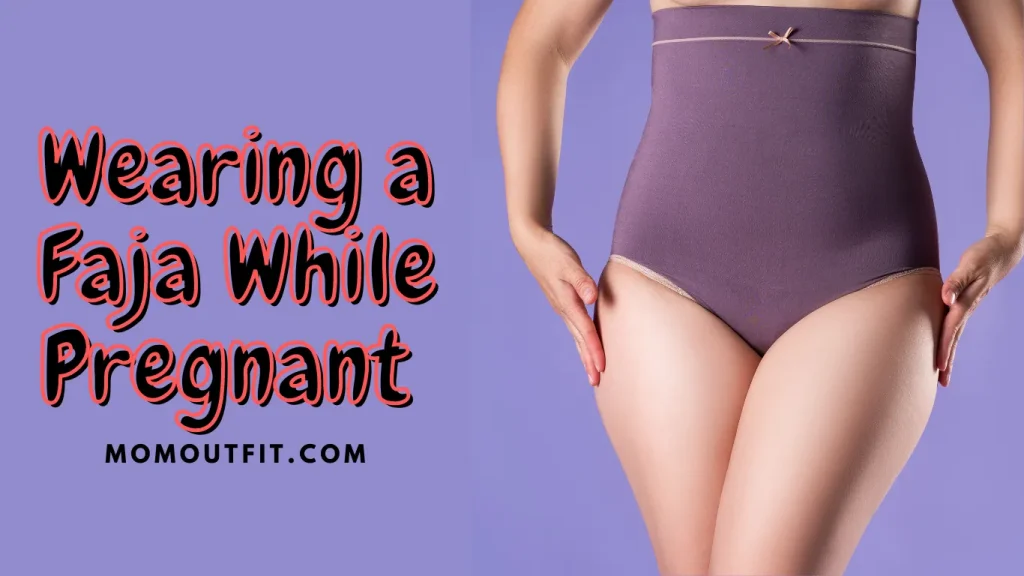Fajas are special garments to shape a person’s body. They are popular because they can make someone’s figure look nicer. Likewise, you can find fajas in different sizes, materials, and styles to select the fittest one. But a debate goes there: is wearing a faja while pregnant safe?
The main purpose of Fajas is to smooth out any bumps or lumps on the body. They can shape targeted areas like the waist, hips, and thighs. They are often used after birth or surgery and for everyday use as shapewear. During the postpartum and postsurgical period, new mothers love to hide unwanted bulges or lumps by wearing this clothing.
Can you wear a faja while pregnant? Well, there are mixed opinions about whether you should wear them. In this article, I will answer regarding wearing fajas during pregnancy. They can be safe till you follow doctor’s advice.

What Is a Faja: Can You Wear Faja While Pregnant?
A faja is a garment that helps shape and compress specific areas of the body, like the waist, hips, and thighs1. It is commonly used for body contouring and support.
You can buy versatile styles and materials of fajas like full-body jumpsuits, tight belly bands, Lycra, cotton, nylon, and latex. The fabric choice can affect the level of compression and the overall effect on the body.
You can wear them for various reasons, like postsurgical recovery, body contouring, and everyday support. Even you can use it after liposuction or as a Brazilian butt lift (BBL). They can also be used without surgery to achieve a slimmer waistline and enhanced curves.
Like any garment, wearing a faja has its pros and cons. Some benefits include improved posture, enhanced appearance, and temporary relief from back pain.
Suppose you wear it too tightly or for long periods. In that case, it can cause discomfort, restrict movement, and potentially harm the baby during pregnancy2. So, you should consult your doctor about wearing a faja while pregnant.
Fajas and Pregnancy: Can I Wear a Faja While Pregnant?
Arguments for wearing a faja while pregnant include supporting the abdominal muscles and lower back. It can alleviate pain and fatigue from everyday activities3. Also, they can improve posture, which might be affected by the physical changes during pregnancy.
Arguments against wearing a faja during pregnancy mainly revolve around potential health risks. Wearing a faja too tightly or for long periods can restrict proper circulation in the body. It can cause other health concerns. Also, fajas can cause discomfort, restrict movement, and harm the baby during pregnancy.
Potential Benefits of Wearing a Faja While Pregnant
Why should you wear a faja during pregnancy? Wearing a faja while pregnant offers several benefits:
Stylish & Aesthetic Look
Fajas can help create a smooth waistline and conceal unwanted lumps or bumps. They give you a more flattering appearance 4, 5.
Body Contouring and Slimming Effect
Fajas can provide a slimming effect while controlling bloating. You will feel more confident in your appearance.
Post-surgery and Postpartum Support
A faja can provide support and light compression for the abdominal area and lower back. It may alleviate uterus swelling, discomfort, fatigue, and pain during pregnancy6. Also, wearing it can provide compression to help the body recover and regain its core strength and shape.
Posture Support
Fajas improve posture by supporting the back and keeping the spine in alignment. They reduce pressure on the spine and affected areas7.
Pain and Discomfort Reduction
Wearing a faja can reduce pain and discomfort associated with post-pregnancy conditions like Diastasis Recti and back pain.
Increased Thermal Activity and Blood Flow
Fajas can increase thermal activity to have a positive effect on blood flow. It may help get rid of toxins and potentially aid in weight management during pregnancy8.
Potential Risks of Wearing a Faja While Pregnant: Is It Bad to Wear a Faja While Pregnant?
You can surely wear fajas during and after pregnancy. But there are some risks and concerns about wearing a faja while pregnant:
Restricted Movement and Breathing
Wearing a faja during pregnancy may restrict movement. Also, it can make breathing difficult if the compression is too tight4.
Increased Body Temperature and Sweating
Fajas can increase body temperature and cause sweating due to the compression and the materials used. It may lead to discomfort and potential skin irritation, especially during pregnancy.
Potential Impact on Blood Circulation
If a faja is too tight, it may restrict blood flow. It can be harmful to both the mother and the baby. So, choosing a faja with low-to-medium compression is important to avoid this risk. However, there is no direct evidence linking Fajas to this issue.
Pressure on the Bladder and Digestive System
A faja may exert pressure on the bladder and digestive system. It may cause discomfort or other complications.
Potential Harm to the Baby
Tight compression around the abdomen could potentially harm the baby during pregnancy.
Impact on Fetal Development
Tight garments may potentially restrict fetal movement, although no direct evidence links Fajas to this issue. Reduced and excessive fetal movements have been associated with poor prognosis for neonates.
Increased Risk of Preterm Labor
There is indeed no direct evidence linking Fajas to an increased risk of preterm labor. It is important to consider that any restrictive garment or factor that puts pressure on the uterus could potentially impact pregnancy outcomes 9, 10.
Alternatives to Fajas for Pregnant Women
You can wear these alternatives to fajas during pregnancy:
Maternity Support Belts
These belts support the lower back and abdomen without restricting blood flow or causing discomfort. They can alleviate back pain and improve posture during pregnancy.
Supportive Clothing
Supportive maternity clothing (like leggings and pants with built-in support panels) provides gentle support for the abdominal area without tight compression. They are secure and can be worn throughout the day.
Pregnancy Pillows
Pregnancy pillows support the growing belly and alleviate discomfort during sleep. It can reduce back pain and improve overall comfort.
Exercise and Stretching
Gentle exercises and stretching (like prenatal yoga or Pilates) can improve posture, strengthen muscles, and alleviate discomfort during pregnancy11.
Tips for Choosing the Right Faja: How to Select Faja for Pregnancy
Tips for choosing the right faja or alternative support for pregnant women:
Identify Your Needs
Determine which areas of your body you need support, like the lower back, abdomen, or hips. It will help you choose the right type of support garment8.
Sizing and Fit Considerations
Choose the right size for your support garment to ensure comfort and effectiveness. Use the manufacturer’s size guide to find the size for your body measurements. A proper fit is crucial for comfort and effectiveness13.
Material and Construction
Look for support garments made from breathable and comfortable materials (like Powernet, a blend of nylon and spandex). A lining in the torso can also help comfort and prevent skin irritation14.
Consider the Level of Compression
Different support garments offer varying levels of compression. For pregnant women, select low-to-medium compression to avoid discomfort and restricted blood flow.
Look for Adjustable Features
Adjustable straps and closures can help you customize the fit of your support garment for the pregnant body. Prioritize comfort by choosing garments with features like hypoallergenic cotton lining15. Also, wear fajas from breathable and comfortable materials, like hypoallergenic cotton lining, to avoid skin irritation.
Consult a Healthcare Professional
Before purchasing a faja or alternative support garment, please consult with your healthcare provider. Make sure it is safe and suitable for your needs during pregnancy.
Duration and Frequency of Wearing a Faja
How long can you wear faja during pregnancy? Well, start by wearing the faja for shorter periods, like 2 hours a day. Then, gradually increase the duration as your comfort level increases. Aim to wear the faja for around 8-10 hours a day. But do not force yourself to wear it for longer periods if it causes discomfort.
Stay Dry
Ensure your skin is dry before wearing the faja to prevent irritation or bacteria buildup. Consider using baby powder underneath the faja to help with fitting and comfort.
Recommended Faja for Pregnancy
- Fajas Colombianas Body Shaper
- Sonryse Colombian Fajas Post Surgery
- Naomi and Nicole Thigh Slimming Torsette
- Maidenform Minimizing Hi-waist Fajas Shapewear
- Women’s Convertible Slip with Built In Bra & Anti-Static Fajas Shapewear
- Hanes Light Tummy Control Shapewear Brief Fajas
- Flexees Maidenform Firm Foundations Hi-Waist Thigh Slimmer
- Bali Lace ‘N Smooth Shapewear
- Maidenform Open Bust Body Shaper
- Maidenform Flexees Women’s Shapewear Hi-Waist
Frequently Asked Questions
- Can wearing a faja during pregnancy cause harm to the baby?
- If you do not wear faja too tightly, it won’t affect your baby.
- How can I ensure that I am wearing a faja correctly during pregnancy?
- Make sure the Faja is comfortable, non-restrictive, and does not cause any discomfort.
- What are some signs that I should stop wearing a faja while pregnant?
- Suppose you experience pain, discomfort, or any negative effects while wearing a Faja during pregnancy. In that case, you must stop wearing it and consult with your healthcare professional.
- Can I wear a faja after giving birth to help with postpartum recovery?
- Yes, postpartum girdles can be beneficial for postpartum recovery. They provide support and improve posture.
- Is it safe to wear a faja during the entire duration of pregnancy?
- You can wear it for 2-3 hours at stretch and 8-10 hours a day maximum.
- Can wearing a faja affect the baby’s development?
- No direct evidence linking Fajas to affecting the baby’s development is available. However, any restrictive garment or factor that puts pressure on the uterus could impact pregnancy outcomes.
- How tight should a faja be when worn during pregnancy?
- You should choose a comfortable and non-restrictive faja that does not cause discomfort.
- Are there any specific exercises or activities that should be avoided while wearing a faja?
- Consult your physician for guidance on exercise and activities during pregnancy wearing faja.
Conclusion: Wearing a Faja While Pregnant
So, is it bad to wear a faja while pregnant? Yes, or no?
In this article, I have given you answers on behalf of and against wearing faja during pregnancy.
Remember, wearing faja can support the lower back and abdomen, potentially reducing discomfort and pain. Also, it can improve posture by providing back and bust support.
There is a potential risk of restricted blood flow if the compression is too tight. Again, there is a possibility that you may feel discomfort or irritation if the faja is not properly fitted or made from unsuitable materials.
So, I suggest you select a faja with low-to-medium compression, breathable materials, and adjustable features for comfort and proper fit. Then, monitor your comfort and well-being while wearing the faja. Discontinue use if you experience any discomfort or complications.
If anything appears confusing, ask your doctor whether you can wear faja while pregnant. Please, leave any essential feedback (if any) in the comment section. Thanks a lot!
References:
- https://fajas.com/
- https://kimmicouture.com/pages/colombian-faja-faqs
- https://www.yougettingpregnant.com/do-fajas-work-after-pregnancy-2/
- https://www.luxxcurves.com/blogs/waist-training/do-fajas-work
- https://sittsperfect.com/sitts-posture-cushion-lower-back-pain-relief-and-lumbar-support/
- https://www.webmd.com/baby/what-is-postpartum-belly-wrap
- https://stylewithbenefits.com/does-shapewear-help-back-pain/
- https://shapessecrets.com/blogs/news/what-are-fajas-good-for-myths-and-facts
- https://www.luxxcurves.com/blogs/waist-training/do-fajas-work
- https://www.healthline.com/health/pregnancy/preterm-labor-risk-factors
- https://www.stanfordchildrens.org/en/topic/default?id=preterm-labor-90-P02497
- https://srchealth.com/blogs/news/the-good-the-bad-and-the-ugly-of-belly-belts-maternity-belts-and-pregnancy-belts
- https://fajascolombianascf.com/blogs/news/what-is-a-colombian-faja
- https://www.omahaliposuction.com/what-are-fajas-when-should-i-wear-one/
- https://romanceboutiquesecrets.com/products/smart-fit-curve-extra-hip-and-butt-stretch-bbl-post-op-short-faja-stage-2

Born in Texas, Jennifer loves to spend time with her kids. Often, she shares her thoughts from the experience of being a mother. She focuses on surprising the Momoutfit readers with incredible information. Her vision is being a better mother, a visionary person.
